Governments are mandating mass quarantines, shelter-in-place, and social distancing at a scale never seen before in human history. Companies are responding by closing offices and asking employees to work from home. COVID-19 is driving unprecedented demand for broadband internet service, and traditional fixed wire providers are struggling to provide the capacity that customers need. 5G network deployment couldn’t be coming at a better time, providing additional high-speed, high-density capacity at a time when users need it most.
A Spike in Demand for Broadband at Home: 5G Comes at the Perfect Time
Four main factors are causing a dramatic increase in the demand for broadband internet capacity.
- Companies are asking employees to work from home, and schools have shifted to online-learning formats.
- The technologies (such as video conferencing) that power your virtual workforce consume a lot of bandwidth.
- Social distancing is driving personal interactions online.
- Video streaming (which consumes a lot of network bandwidth) has become the go-to mode of entertainment.
When you add these factors together and compound them by the number of people working from home and the density of housing (particularly in cities and suburbs), it is easy to see what the demand challenge is for communication service providers (CSPs) in the telecommunications industry.
The Scalability Challenge of Fixed-Wire Residential Networks
Most home broadband connections today are “fixed-wire” connections, running over cable systems, phone lines, or fiber-optic cables. These carrier networks were designed for a specific capacity based on “normal usage” when most users are at work during the day and doing primarily personal activities on the network in the evening and on weekends. Business networks were designed to support the high-capacity needs of the workplace – not residential networks. The challenge CSPs are facing today is the demand for business communications is shifting from the business networks to residential networks that aren’t designed to handle the load. Some users have dedicated bandwidth (common with fiber connections), but others share bandwidth with their neighbors. With everyone working and learning from home, the available bandwidth is being consumed – slowing down performance for everyone.

Increasing residential network capacity is tough. Scaling capacity is limited by both the bandwidth limitation of the wires in the ground and the network gear deployed in the field. CSPs can’t just increase capacity with a few keystrokes. It requires laying new cables, acquiring new network equipment, and coordinating installation with limited staff. Yes, the fixed-wire infrastructure will catch up, but it won’t be fast enough to address the immediate needs of users.
Mobile Networks Provide a Solution: 5G
Mobile broadband via cellular networks provides a possible solution to our residential broadband challenge.
- Many of the devices (such as phones and tablets) that are used for personal activities and online learning have the ability to connect to cellular networks.
- Mobile carriers can deploy wifi-hotspots to users enabling home networks to leverage mobile networks.
- Mobile networks only require fixed-wire infrastructure to the tower, not to the home.
It is a lot more scalable to extend mobile network capacity into dense residential areas than fixed-wire networks. The challenge with mobile networks is that they too are capacity constrained. Without going into a lot of technical details, 4G and LTE mobile networks are designed and optimized for medium capacity over a medium range. The goal was to provide a consistent blanket of coverage and fix the “dead-spot” problem that 3G and earlier mobile networks encountered. In rural areas and towns, this approach works fine (and will likely satisfy the current needs). In cities and dense residential areas, cell towers are closer together, so we don’t need as much range. What we need is more capacity. This is what 5G networks are all about.
What are 5G Networks?
The 5th generation of mobile networks (referred to as 5G) is designed for high-density areas. The first test deployments were in places like sports arenas and stadiums where there are large numbers of users in a small space requiring high-speed, high-bandwidth connectivity for things like streaming video. CSPs are now deploying 5G networks in cities and suburban areas to address the demands for streaming video and other high-bandwidth applications. These network deployments are what you hear about in TV ads and read about in the news – 5G networks deployed into communities. 5G mobile networks have the potential to increase mobile broadband capacity by as much as 10x in the next six months.
With the spike in demand for network capacity, 5G network deployment couldn’t come at a better time. (Unless of course, that time were last year before the pandemic started). Mobile carriers are well-positioned to accelerate 5G deployment timelines to bring much-needed capacity to densely populated areas that fixed-wire residential networks simply can’t support. Because these deployments take place on centralized cellular towers that service an entire neighborhood instead of requiring infrastructure upgrades to individual buildings, 5G networks can be built out faster and cheaper than fiber and cable networks.
One More Speedbump Ahead
Harnessing the full power of 5G networks will require both additional 5G networking equipment and more 5G capable devices in the hands of end-users. It is the availability of these devices that are likely going to become the constraint to adoption and the full realization of 5G potential over the next few months. Mobile operators’ ability to rapidly acquire the infrastructure equipment they need and production capacity (for 5G wireless hotspots in particular) will determine how quickly current wireless capacity is maxed out and how rapidly overall capacity can be expanded.
The COVID-19 crisis is driving unprecedented demand for broadband service and network capacity. 5G networks have been in development for a couple of years, and they are now available in most cities and urban areas. The shift to 5G couldn’t come at a better time. End-users have a real demand for the capacity, and carriers know what they need to do to overcome the last speedbump and take 5G mainstream. Now, let’s get it done!
Summary:
Why 5G Networks Couldn’t be Coming at a Better Time
Governments are mandating mass quarantines, shelter-in-place, and social distancing at a scale never seen before in human history. Companies are responding by closing offices and asking employees to work from home. COVID-19 is driving unprecedented demand for broadband internet service, and traditional fixed wire providers are struggling to provide the capacity that customers need. 5G network deployment couldn’t be coming at a better time, providing additional high-speed, high-density capacity at a time when users need it most. A Spike in Demand for Broadband at Home. Four main factors are causing a dramatic increase in the demand for broadband internet capacity. 1. Companies are asking employees to work from home, and schools have shifted to online-learning formats. 2. The technologies (such as video conferencing) that power your virtual workforce consume a lot of bandwidth. 3. Social distancing is driving personal interactions online. 4. Video streaming (which consumes a lot of network bandwidth) has become the go-to mode of entertainment.




